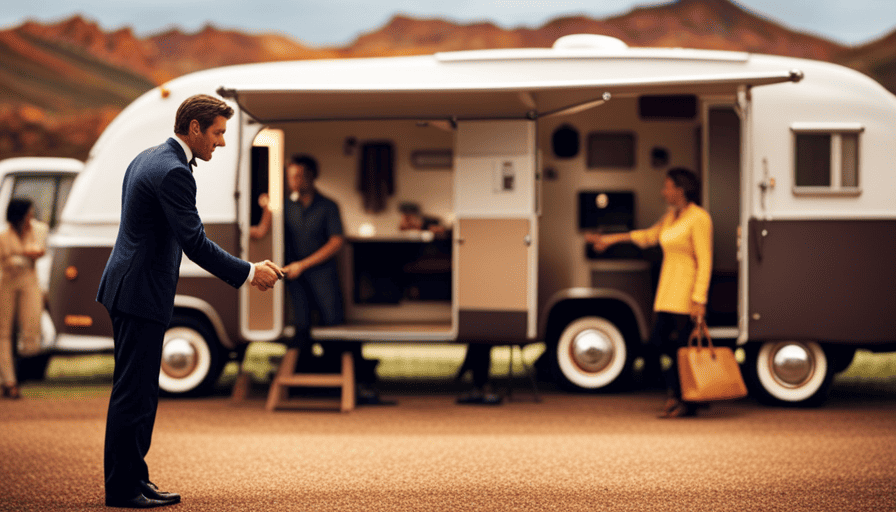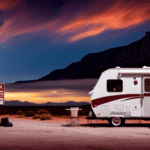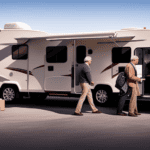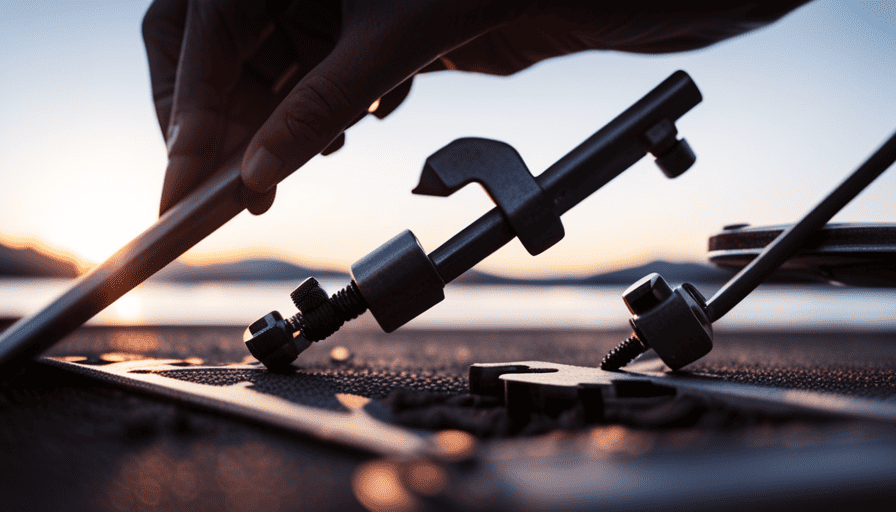Are you prepared to start a fresh journey and bid farewell to your cherished camper? Selling a camper on your own might seem overwhelming, but worry no more! We’re here to walk you through every stage of the process, guaranteeing a seamless and gratifying transaction for you and the prospective buyer.
First and foremost, it is crucial to assess the condition of your camper. By thoroughly inspecting every nook and cranny, you can accurately determine its value and address any necessary repairs or maintenance.
Then, prepare your camper for sale by giving it a thorough cleaning and organizing its contents.
Next, determine a fair asking price by researching the market and considering factors such as age, condition, and features. Taking high-quality photos that showcase your camper’s best features will attract potential buyers and increase your chances of a successful sale.
Crafting an accurate and descriptive listing is key to capturing the interest of potential buyers. Responding promptly to inquiries and scheduling viewings will demonstrate your commitment and professionalism.
Stay tuned for the rest of our article, as we delve deeper into negotiating, finalizing the sale, completing necessary paperwork, and providing a smooth and satisfying experience for the buyer. Get ready to sell your camper with confidence and ease!
Key Takeaways
- Assess the condition of your camper and address any necessary repairs before selling.
- Clean and organize your camper to create a spacious and inviting atmosphere.
- Research the market to determine a fair asking price based on age, condition, and features.
- Take high-quality photos and write an accurate and descriptive listing to attract potential buyers.
Assess the Condition of Your Camper
Before you even think about selling your camper, take a moment to really assess its condition and let the memories flood in, so you can find the perfect buyer who’ll appreciate it just as much as you did. Assessing the value of your camper is crucial in determining a fair asking price.
Consider factors like the age, model, mileage, and overall condition. Conducting inspections, both internally and externally, will give you a clear understanding of any repairs or maintenance needed. Take note of any dents, scratches, or mechanical issues that may affect the value. By being transparent about the condition, you build trust with potential buyers.
When assessing the value, it’s important to consider the market demand for campers similar to yours. Research online listings and compare prices to ensure you’re pricing your camper competitively. Remember, a well-maintained camper will attract interested buyers more effectively.
Transitioning into the next section, cleaning and preparing your camper for sale is the next crucial step in the process. It’s essential to present your camper in its best possible light, both visually and mechanically, to maximize its appeal.
Clean and Prepare Your Camper for Sale
First, take a step back and envision the delighted look on the potential buyer’s face as they step inside your well-maintained and sparkling camper. Preparing and cleaning your camper thoroughly is essential to make a great first impression and increase its value.
Here are five key steps to help you get started:
-
Declutter and organize: Remove any personal items and clutter to create a spacious and inviting atmosphere. Organize storage spaces and cabinets to showcase available storage options.
-
Deep clean interior and exterior: Scrub every nook and cranny, including floors, walls, and windows. Polish the exterior and give it a fresh coat of wax to make it shine.
-
Check and repair: Inspect all appliances and systems, ensuring they’re in good working condition. Fix any minor issues like leaky faucets or loose screws.
-
Enhance curb appeal: Trim bushes, mow the lawn, and pressure wash the exterior to make your camper look well-maintained from the outside.
-
Stage for success: Set up the interior with attractive and functional decor. Use neutral colors and add cozy touches to make potential buyers feel at home.
By preparing and cleaning your camper meticulously, you not only increase its desirability but also demonstrate your commitment to maintaining its value.
Now, let’s move on to determining a fair asking price for your camper.
Determine a Fair Asking Price
To ensure you get the best value for your beloved home away from home, it’s time to determine a fair asking price for your camper.
Determining the value of your camper can be a bit tricky, but with the right pricing strategies, you can attract potential buyers and maximize your selling price.
First, consider the condition and age of your camper. Take into account any upgrades, repairs, or maintenance you’ve done. This will help you gauge its current market value.
Next, research similar campers for sale in your area. Look at online listings, dealerships, and classified ads to get an idea of what others are asking for similar models.
It’s important to be realistic and competitive with your pricing. If you set the price too high, potential buyers may overlook your camper. On the other hand, pricing it too low could make buyers suspicious of hidden issues.
Consider negotiating room when setting your asking price, but also keep in mind that buyers will likely try to negotiate a lower price.
Determining a fair asking price is crucial to attracting potential buyers and getting the best value for your camper.
Now that you’ve determined the value of your camper, it’s time to showcase its best features by taking high-quality photos.
Take High-Quality Photos of Your Camper
Capture the essence of your beloved home away from home by taking high-quality photos that showcase its best features. When selling your camper privately, the quality of your photos can greatly impact potential buyers’ interest.
To make your camper stand out, get creative with angles and lighting techniques. Experiment with different perspectives to highlight the spaciousness of the interior or the sleek lines of the exterior. Take advantage of natural light by opening curtains and blinds to create a warm and inviting atmosphere. If needed, consider using additional lighting sources to brighten up darker areas.
When photographing the interior, focus on the unique amenities and storage options that your camper offers. Highlight the kitchen area, sleeping quarters, and any special features that make your camper comfortable and practical.
For the exterior shots, emphasize the overall condition of the camper, its size, and any additional features such as awnings or outdoor seating areas.
By capturing stunning and appealing photos, you can entice potential buyers to envision themselves enjoying their own adventures in your camper. These high-quality images will make your listing stand out among the competition and generate more interest.
In the next section, we will discuss how to write an accurate and descriptive listing that complements your captivating photos.
Write an Accurate and Descriptive Listing
Highlight the unique features and amenities of your beloved home away from home in a compelling and heartfelt listing. When writing your listing, it’s important to adopt an effective communication style that captivates potential buyers.
Start by providing a clear and accurate description of your camper, emphasizing its standout qualities. Use persuasive language to showcase its unique features, such as a spacious interior layout, modern appliances, or a luxurious bathroom.
Engage the audience by creating sub-lists in your listing to highlight three key aspects of your camper:
-
Comfort: Describe the cozy sleeping arrangements, plush seating, and climate control options that create a comfortable living space for your future buyers.
-
Convenience: Mention the fully equipped kitchen, ample storage spaces, and user-friendly technology that make life on the road a breeze.
-
Adventure: Highlight the camper’s rugged construction, all-terrain capabilities, and off-grid amenities that enable unforgettable outdoor adventures.
By employing this persuasive and customer-oriented writing style, you can effectively communicate the value of your camper to potential buyers.
Once your listing is complete, it’s time to take the next step and advertise your camper on online platforms.
Advertise Your Camper on Online Platforms
Attract a wide range of interested buyers by showcasing your camper’s unique features and amenities on popular online platforms. Utilizing effective marketing strategies is essential in order to reach potential buyers and increase the chances of selling your camper. Here are some tips for attracting potential buyers and ensuring a successful sale.
Firstly, make sure your listing is detailed and engaging. Highlight the standout features of your camper, such as a spacious interior, modern kitchen appliances, or a luxurious sleeping area. Use compelling language to create a sense of excitement and desirability.
Next, include high-quality photos that showcase your camper from different angles. Clear, well-lit images will capture the attention of potential buyers and give them a better idea of what to expect. Consider taking photos during the day to maximize natural lighting and make your camper appear more inviting.
Additionally, provide accurate and thorough information about your camper’s condition, maintenance history, and any recent upgrades or repairs. Being transparent and honest will build trust with potential buyers and increase the likelihood of a successful sale.
By effectively marketing your camper and using these tips for attracting potential buyers, you can generate interest and inquiries.
In the next section, we will discuss how to respond promptly to inquiries and schedule viewings to ensure a smooth selling process.
Respond Promptly to Inquiries and Schedule Viewings
After advertising your camper on various online platforms, you can expect to receive inquiries from potential buyers. It’s crucial to respond promptly and professionally to these inquiries to maintain their interest and ensure a smooth selling process. Prompt response demonstrates your commitment as a seller and creates a positive impression in the buyer’s mind.
When responding to inquiries, make sure to provide all the necessary information about your camper, such as its condition, features, and any recent maintenance or upgrades. Answer any questions the buyer may have and offer to schedule a viewing at their convenience. Efficient scheduling is key to accommodating potential buyers and showing them your camper in person.
By promptly responding to inquiries and efficiently scheduling viewings, you’re increasing your chances of making a successful sale. It shows that you value their time and are committed to providing excellent customer service.
Now that you’ve generated interest and scheduled viewings for your camper, the next step is to negotiate and finalize the sale. This involves discussing the price, terms, and conditions with the potential buyer.
Negotiate and Finalize the Sale
Once you’ve sparked the buyer’s interest and arranged viewings, it’s time to roll up your sleeves and get down to business, negotiating and finalizing the sale like a seasoned pro, sealing the deal as smoothly as a well-oiled machine.
To ensure a successful negotiation, consider the following strategies:
-
Set a competitive price: Research the market value of similar campers to determine a fair asking price. Be prepared to negotiate, but also know your bottom line.
-
Highlight the camper’s unique features: Emphasize the camper’s standout qualities to justify your asking price. Whether it’s a luxurious interior or advanced safety features, showcase what makes your camper special.
-
Be flexible: Negotiation is a give-and-take process. Be open to reasonable offers and consider compromising on certain terms to reach an agreement that satisfies both parties.
Once you’ve reached an agreement, it’s crucial to ensure a secure payment process. Consider using a secure online platform or escrow service to protect both yourself and the buyer. Verify the payment before finalizing the sale to avoid any potential scams or fraudulent transactions.
With the negotiation and payment process complete, it’s time to move on to the next step: completing the necessary paperwork and transferring ownership.
Now, let’s discuss how to complete the necessary paperwork and transfer ownership smoothly and efficiently.
Complete the Necessary Paperwork and Transfer Ownership
Now that the deal is sealed, it’s time to smoothly handle the necessary paperwork and transfer ownership, ensuring a seamless transition into the hands of the new owner.
The paperwork process can seem daunting, but with the right guidance, it can be a breeze. First, gather all the relevant documents, such as the title, bill of sale, and any maintenance records. Make sure to double-check that everything is in order and up to date.
Next, it’s crucial to transfer ownership correctly. Fill out the necessary forms, including the title transfer form, and make sure both parties sign it. Additionally, some states may require a release of liability form to protect the seller from any future issues.
Once all the paperwork is completed and signed, it’s time to submit it to the appropriate authorities. This typically involves going to the local Department of Motor Vehicles or similar agency. Be prepared to pay any applicable fees during this step.
By completing the necessary paperwork and ensuring a smooth ownership transfer, you’re providing a smooth and satisfying experience for the buyer. This attention to detail and thoroughness will leave a positive impression, making the entire buying process enjoyable and hassle-free.
Provide a Smooth and Satisfying Experience for the Buyer
Ensure that the buyer’s experience is seamless and enjoyable by providing exceptional service and attention to detail. Building trust and buyer satisfaction are crucial in selling a camper privately. Here are three ways to provide a smooth and satisfying experience for the buyer:
-
Communication: Maintain open and regular communication with the buyer. Answer their questions promptly and provide detailed information about the camper’s features, condition, and history. Be transparent about any known issues or repairs. This will help build trust and reassure the buyer that they’re making a well-informed decision.
-
Presentation: Prepare the camper for viewing by cleaning it thoroughly and making necessary repairs or improvements. Take high-quality photos from different angles, highlighting its best features. Create a detailed and accurate listing that includes all relevant information. This attention to detail will showcase your professionalism and give the buyer confidence in their purchase.
-
Test Drive: Offer the buyer the opportunity to test drive the camper. This’ll allow them to experience its performance and functionality firsthand. Accompany them during the test drive, answering any questions and addressing any concerns they may have. This personalized approach will demonstrate your commitment to their satisfaction.
By following these steps, you can provide a seamless and enjoyable experience for the buyer, building trust and ensuring buyer satisfaction.
Frequently Asked Questions
How do I find potential buyers for my camper?
To find potential buyers for your camper, we can explore various effective advertising methods.
Online platforms like social media, classified websites, and camper-specific forums provide a wide reach for your listing. Consider using compelling visuals and engaging descriptions that showcase the camper’s unique features.
Additionally, word-of-mouth can be powerful, so spread the word among friends, family, and colleagues.
With our expertise, we’ll guide you towards the right audience, ensuring a successful sale.
What are some common mistakes to avoid when selling a camper privately?
Common pricing mistakes to avoid when selling a camper privately include overpricing and underpricing. Overpricing can deter potential buyers, while underpricing can result in a loss of profit. To ensure a fair price, research the market value of similar campers and consider the condition, age, and features of your camper.
Effective advertising strategies are crucial in attracting potential buyers. Utilize online platforms, such as social media and classified ads, to reach a wider audience. Provide detailed descriptions and high-quality photos to showcase your camper’s unique features and attract buyers.
Is it better to sell my camper as-is or should I make any repairs before listing it for sale?
When it comes to selling our camper, we have to weigh the pros and cons of selling it as-is or making repairs before listing it.
Selling as-is may attract buyers looking for a fixer-upper, but we could also risk a lower selling price.
On the other hand, making repairs can increase the value and appeal to a wider range of buyers.
Ultimately, it depends on our budget, time, and the condition of the camper.
Are there any specific documents or paperwork I need to have in order to sell my camper?
To sell a camper privately, there are specific paperwork and legal requirements you need to have in order to ensure a smooth transaction. These include the title or ownership documents, transfer of ownership forms, and any maintenance or repair records.
Having these documents ready not only gives potential buyers peace of mind but also helps you establish trust and credibility. By being thorough and organized with your paperwork, you can make the selling process much easier for both parties involved.
How do I handle payment and ensure a secure transaction when selling my camper privately?
Handling payment and ensuring a secure transaction when selling your camper privately is crucial. To ease any concerns, we recommend using a trusted online payment platform, such as PayPal or Venmo. These platforms offer buyer and seller protection, safeguarding both parties involved.
Additionally, consider meeting in a well-lit public space, like a bank or police station parking lot, to exchange payment and complete the transaction. Prioritizing safety and transparency will provide peace of mind for all involved.
What Are the Steps to Selling a Camper Trailer Privately?
Selling a camper trailer privately involves a few crucial steps. Firstly, thoroughly clean and organize the camper to make it look presentable. Next, take high-quality photos highlighting its features and upload them to relevant online platforms. Write a compelling description emphasizing its advantages. Set a reasonable price for the sell camper trailer and negotiate with potential buyers. Finally, ensure the paperwork is in order and complete the transaction legally and securely.
Conclusion
In conclusion, selling your camper privately can be a rewarding experience. By following the steps outlined in this article, you can ensure a smooth and successful sale.
Remember to assess the condition of your camper, clean and prepare it for sale, determine a fair asking price, take high-quality photos, write an accurate listing, respond promptly to inquiries, negotiate effectively, complete necessary paperwork, and provide a satisfying experience for the buyer.
With these tips, you’ll be on your way to finding the perfect new owner for your beloved camper. So don’t delay, start the selling process today and hit the road towards your camper’s new adventure!



















